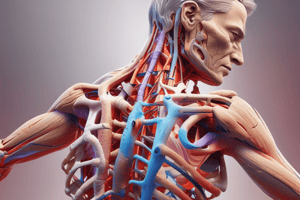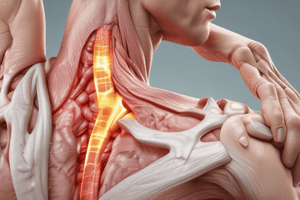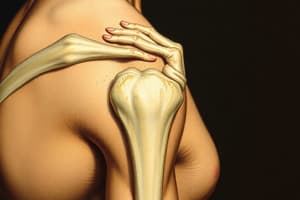Podcast
Questions and Answers
Which combination of motions during the Apprehension Crank test would MOST likely indicate gross instability or dislocation of the glenohumeral joint?
Which combination of motions during the Apprehension Crank test would MOST likely indicate gross instability or dislocation of the glenohumeral joint?
- 90 degrees adduction with full external rotation, followed by the application of anterior pressure and hypermobility.
- 90 degrees abduction with full internal rotation, followed by the application of overpressure, producing pain.
- 90 degrees abduction with full external rotation, followed by the application of overpressure, resulting in apprehension. (correct)
- 90 degrees adduction with full internal rotation, followed by the application of anterior pressure without muscle spasm.
During the Posterior Drawer test for glenohumeral joint instability, at what degree of forward flexion should the humerus be positioned to BEST assess posterior instability?
During the Posterior Drawer test for glenohumeral joint instability, at what degree of forward flexion should the humerus be positioned to BEST assess posterior instability?
- 10-20 degrees
- 90-100 degrees
- 60-80 degrees (correct)
- 40-50 degrees
What is the MOST important element when performing the Apprehension Crank test effectively?
What is the MOST important element when performing the Apprehension Crank test effectively?
- Stabilizing the scapula to isolate glenohumeral movement.
- Applying overpressure slowly to accurately assess apprehension. (correct)
- Maintaining the arm in adduction throughout the movement.
- Applying force rapidly to identify subtle instability.
In the Push-Pull test, what specific action should the examiner take with their hands to identify posterior instability of the glenohumeral joint?
In the Push-Pull test, what specific action should the examiner take with their hands to identify posterior instability of the glenohumeral joint?
What is the MOST critical observation during the Sulcus Sign test that indicates inferior glenohumeral joint instability?
What is the MOST critical observation during the Sulcus Sign test that indicates inferior glenohumeral joint instability?
Flashcards
Anterior Drawer Test
Anterior Drawer Test
Assesses anterior GH joint instability or labral tear.
Apprehension Crank Test
Apprehension Crank Test
Evaluates gross instability of GH joint/dislocation.
Posterior Drawer Test
Posterior Drawer Test
Checks for posterior instability of the GH joint.
Push Pull Test
Push Pull Test
Signup and view all the flashcards
Sulcus Sign Test
Sulcus Sign Test
Signup and view all the flashcards
Study Notes
Shoulder Special Tests
- Anterior Drawer: Tests for anterior GH joint instability or labral tear. Positive sign is clicking or apprehension.
- How to perform: Patient supine, examiner abducts shoulder 80-120 degrees, forward flexes 20 degrees, laterally rotates 30 degrees, stabilizes scapula, and draws the humerus upward.
- Apprehension Crank: Assesses gross instability of the glenohumeral joint (GH) or dislocation. Positive sign is apprehension and hypermobility (muscle spasm/pain).
- How to perform: Patient supine, passively move client into 90 degrees abduction/full external rotation, apply pressure slowly.
- Posterior Drawer: Assesses posterior instability of the GH joint. Positive sign is pain and apprehension.
- How to perform: Patient supine, abduct to 80-120 degrees, flex to 20-30 degrees, stabilize scapula/rotate arm medially, forward flex to 60-80, apply force to humerus.
- Push Pull Test: Assesses posterior instability of the GH joint. Positive signs involve hypermobility: mild gap (<1cm), moderate (<2cm), severe (>2cm).
- How to perform: Patient supine, abduct to 90, forward flex 30, one hand on humeral head pushes down, other on elbow pulls up.
- Sulcus Sign: Evaluates inferior instability of the GH joint. Positive signs, if any, involve hypermobility (mild, moderate, or severe).
- How to perform: Patient supine, abduct to 90, forward flex to 30, observe if there is an inferior humeral movement. Push humerus inferiorly to test.
- Hawkins-Kennedy Impingement: Identifies supraspinatus tendinosis, paratenonitis, or impingement. Positive sign is pain and apprehension.
- How to perform: Patient seated/standing, forward flex arm to 90 degrees, medially rotate with overpressure.
- Neer Impingement: Assess supraspinatus overuse, subacromial bursitis, or biceps overuse. Positive sign is pain and apprehension.
- How to perform: Seated, abduct arm in scaption with medial rotation.
Wrist/Elbow Special Tests
- Valgus/Varus Stress: Tests for medial and lateral collateral ligament instability. Positive sign is hypermobility (valgus = medial, varus = lateral).
- Cozens Method: Assess inflammation/instability of the lateral epicondyle (tennis elbow). Positive sign is pain.
- Maudsley's / Mill's Method: Test for inflammation of lateral epicondyle (tennis elbow). Positive sign is pain.
- Medial Epicondylitis: Assess inflammation at medial epicondyle (golfer's elbow). Positive sign is pain.
- Pinch Grip: Evaluates interosseus nerve pathology (median nerve). Positive sign is inability to pinch.
Nerve Tension Tests
- Pronator Teres Syndrome: Evaluates the compression of the median nerve due to pronator teres.
- Tinels Test: Assesses ulnar nerve compression by performing a reproduction and pain assessment using tingling sensation with examiner tapping the elbow.
- Murphey Sign: Assess the possibility of a dislocated lunate. Observe the positioning of the third metacarpal bone relative to the second and fourth in relation to locating a positive sign.
- Radial/Ulnar Nerve Ligamentus Stress: Assess pathology of Radial and Ulnar nerves' ligament stability.
- Finklesteins: Assesses the deQuervain's tenosynovitis. Positive sign is a reproduction of pain on thumb movement.
- Froment's: Assesses possible ulnar nerve pathology by the paralysis of abductor pollicis due to ulnar nerve pathology.
- Phalens: Assess carpal tunnel syndrome. Positive sign is pain by pressing the wrists together.
- Reverse Phalens: Assess carpal tunnel syndrome. Positive sign is pain.
- Allen: Assess ulnar/radial artery insufficiency. Positive sign is a lack of colour return to the hand within six seconds.
Range of Motion (ROM)
- Median: Depress and abduct shoulder to 110, extend elbow, forearm supination, wrist extension, fingers and thumb extension on contralateral cervical side flexion.
- Ulnar: Depress shoulder, medial rotation, abduct 40, extend 25, elbow extension, forearm pronation, wrist flexion and ulnar deviation, fingers flexion on contralateral side flexion.
- Radial: Depress and abduct shoulder to 90, elbow flexion, forearm pronation, wrist extension and radial deviation, fingers extension on contralateral side flexion.
Studying That Suits You
Use AI to generate personalized quizzes and flashcards to suit your learning preferences.




